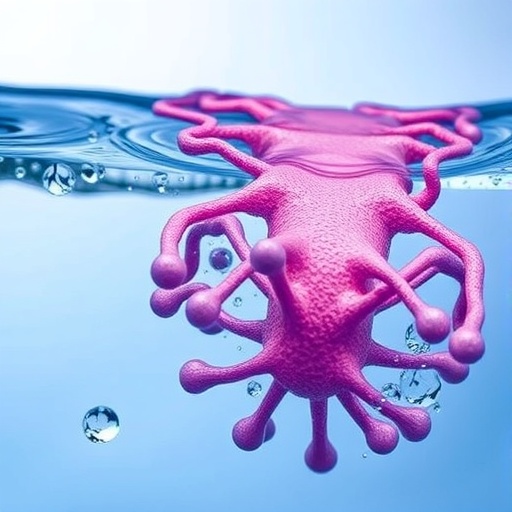
In a groundbreaking study published in the prestigious journal Proceedings of the National Academy of Sciences, researchers from the University of Cambridge and University College London have unveiled a remarkable and previously unrecognized mechanism by which carbon dioxide (CO₂) interacts with the ocean’s surface. This new insight, termed the “In and Out” mechanism, fundamentally challenges long-standing assumptions about the chemical processes driving ocean acidification, a major environmental threat linked to rising global CO₂ emissions.
For decades, scientific understanding of CO₂’s fate in ocean waters has centered on the molecule’s dissolution deep within the bulk water phase, where it reacts with water to form carbonic acid. This acidification process plays a critical role in lowering the ocean’s pH and has far-reaching consequences for marine ecosystems, from coral bleaching to disrupting the food chain. However, previous research largely neglected the subtleties of what occurs at the thin, molecular interface between air and water—where the ocean’s surface meets the atmosphere.
The “In and Out” mechanism discovered by the Cambridge-UCL team reveals that CO₂ does not simply dissolve and diffuse uniformly throughout the water. Instead, the molecule temporarily penetrates just the topmost water layer, which is only a few molecules thick, where it rapidly reacts to form carbonic acid. After this fleeting interaction, the acid species returns to the surface and can disengage back into the air. This behavior contrasts vividly with prior models that assumed CO₂ must fully integrate into the ocean’s volume to undergo chemical transformation.
.adsslot_d8Qmew9fnq{width:728px !important;height:90px !important;}
@media(max-width:1199px){ .adsslot_d8Qmew9fnq{width:468px !important;height:60px !important;}
}
@media(max-width:767px){ .adsslot_d8Qmew9fnq{width:320px !important;height:50px !important;}
}
ADVERTISEMENT
Samuel Brookes, a PhD student at Cambridge’s Yusuf Hamied Department of Chemistry and an author of the study, explained this process vividly: “Imagine CO₂ as a diver performing a quick dip into the water’s very top layer before reemerging—reacting while barely submerging.” The reaction, occurring in this constrained interfacial environment, effectively halves the energetic barrier expected from the denser, bulk water environment. The effect of this dynamic is a substantially faster formation rate of carbonic acid at the ocean’s surface, with profound implications for understanding how swiftly ocean acidification can advance.
One of the study’s most striking revelations is that the chemical energy barrier for CO₂ hydration at the interface remains comparable to, or even less than, that within the bulk solution. This defies conventional wisdom, which predicted that the limited number of water molecules at the surface would retard the reaction. The “In and Out” model clarifies that the peculiar dynamics at play, including CO₂ repeatedly entering and exiting the interface, compensate for the reduced hydration shell, enabling efficient chemistry.
To achieve these insights, the researchers employed cutting-edge machine learning algorithms integrated with quantum chemical calculations. This innovative approach allowed molecular-level simulations that revealed not only the mechanistic pathways but also detailed reaction energies and kinetics with unprecedented accuracy. By training models on high-fidelity quantum data, the team could track CO₂’s behavior at atomic scales, offering a window into an elusive but critical environmental process.
Beyond the fundamental scientific novelty, the findings underscore an urgent need to revisit and refine climate and ocean models. Current estimations of ocean acidification rates may be seriously underestimated if the rapid, interface-mediated CO₂ hydration process is not accounted for. Considering billions of tons of atmospheric CO₂ are absorbed annually, the new mechanism implies oceans could acidify faster, potentially exacerbating ecological damage sooner than anticipated.
The multidisciplinary team, led by Dr. Christoph Schran at Cambridge’s Cavendish Laboratory, noted how incredibly sensitive these reactions are to minuscule spatial changes. “Moving CO₂ by just a fraction of a nanometer—from above the surface to the topmost water molecules—almost halves the reaction energy barrier,” Schran reflected. Such striking spatial sensitivity raises broader scientific questions about other chemical and physical processes occurring at environmental interfaces, suggesting this might be a widespread phenomenon.
Looking forward, the researchers plan to extend their computational models to incorporate the myriad ions naturally present in seawater, such as sodium, chloride, and carbonate. Integrating these species is crucial for achieving simulations that mirror real-world oceanic conditions closely, which will enhance predictions of surface pH variations and further clarify chemical reactivity at interfaces. These expansions could reveal more nuanced pathways affecting ocean chemistry and help inform global climate mitigation strategies.
The study was supported by the Syntech Centre for Doctoral Training and funded by the EPSRC and European Union through the “n-AQUA” ERC project. Computational resources came from the UK Materials and Molecular Modeling Hub as well as the Car-Parrinello consortium. This collaborative effort represents a remarkable confluence of theoretical chemistry, advanced computation, and climate science.
Ultimately, this research not only enhances our understanding of an essential geochemical process but also exemplifies how machine learning and quantum chemistry can intersect to address urgent, real-world environmental challenges. The “In and Out” mechanism vividly redefines the microscopic life of CO₂ molecules at the ocean surface and signals a new era of exploring molecular phenomena at environmental interfaces.
Subject of Research: Hydration and chemical reaction of CO₂ at the air–water interface leading to carbonic acid formation
Article Title: CO2 hydration at the air–water interface: A surface-mediated “in-and-out” mechanism
News Publication Date: 20-Aug-2025
Web References: https://www.pnas.org/doi/10.1073/pnas.2502684122
References: Proceedings of the National Academy of Sciences
Image Credits: Photo by Nathan Pitt | Department of Chemistry, University of Cambridge
Keywords
Chemical physics, Chemical reactions, Physical chemistry
Tags: atmospheric science and climate changecarbon dioxide ocean interactioncarbonic acid formationchemical processes in oceanscoral bleaching researchenvironmental science breakthroughsglobal CO2 emissions effectsmarine ecosystem impactsmolecular interface air waterocean acidification mechanismssurface chemistry of waterUniversity of Cambridge research





